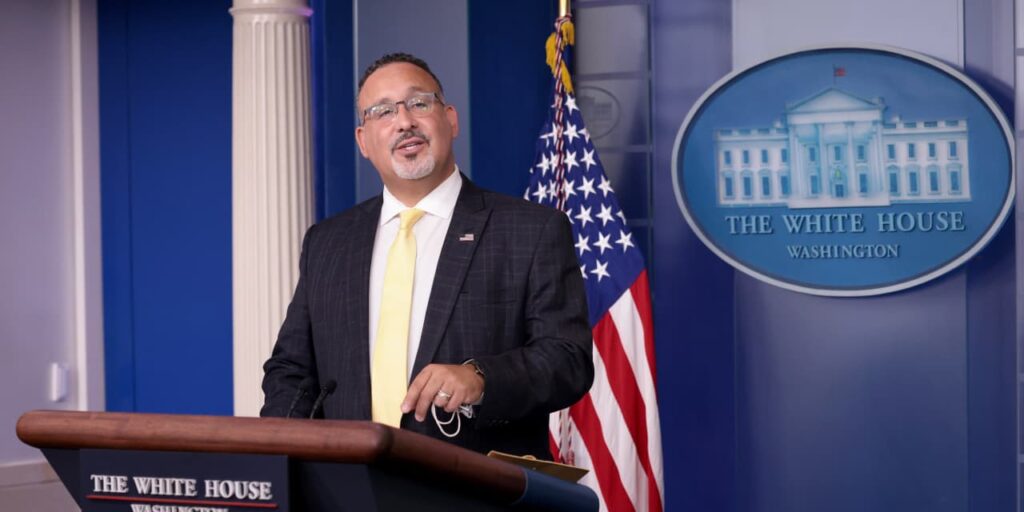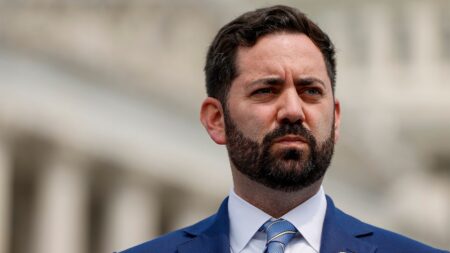The U.S. Department of Education plans to cut down on paperwork requirements for certain students and schools this year amid a challenging rollout of the new FAFSA.
The agency announced Tuesday that it would “significantly” reduce the share of financial-aid applicants subject to verification. That process requires a subset of students flagged by the department to share information with the government beyond what they’ve reported in the Free Application for Federal Student Aid, or FAFSA. The onerous process can put students at risk of not receiving the financial aid they’re eligible for because they don’t follow through with the extra steps.
Secretary of Education Miguel Cardona said the change came in response to “direct feedback” from financial-aid administrators and higher-education leaders. Indeed, at a financial-aid conference last week, representatives from financial-aid offices at several schools said they hoped the department would take this step.
How is the FAFSA rollout impacting you? We want to know. Email jberman@marketwatch.com.
During a typical admissions cycle, verification requests can cause delays in students getting the financial-aid information they need to make a decision about where they’ll attend school. This year, the amount of time that students, including those selected for verification, will have to make their college decision will be crunched significantly due to delays that have plagued the launch of the new FAFSA.
Glitchy rollout puts low-income students at risk
The Department of Education was charged by Congress with making updates to the form and its underlying formula by the end of last year. The goal of the changes was to direct more aid to low-income students, but a glitchy rollout has put those students at the most risk of facing uncertainty around where and if they’ll be able to attend college.
The FAFSA is crucial for both colleges and students and their families in determining how much a household will actually pay for school. Students need to fill it out to get access to federal student loans and grants. Colleges, states and scholarship organizations use the data provided in the form to determine how much of their own money they’ll give to students.
Students and families struggled to access the form in the first several days after the government rolled out the new version of the FAFSA. In addition, the agency said last month that it would implement a fix that would account for inflation when calculating students’ aid levels.
The change will result in an extra $1.8 billion going to students, but it will cause severe delays in schools receiving the information they need to provide students with financial-aid offers. That, in turn, will significantly squeeze the amount of time that students have to review their financial-aid options and make a decision about where to attend college.
Fraud prevention? Or an onerous requirement?
Stringent verification requirements would have added another wrinkle to that timeline. During a typical financial-aid and admissions cycle, the Department of Education asks millions of students who are eligible for a Pell grant to submit extra documentation, like tax transcripts, through a process called verification. The idea behind verification is to prevent fraud, but some college-access advocates have said the requirement essentially asks people to prove that they’re poor.
The process can be time-consuming and results in at least some selected students losing out on their financial aid because they didn’t provide the extra documents. The burden falls disproportionately on students of color. An analysis from the Washington Post indicates that students selected for verification were more likely to be from majority-Black and majority-Hispanic neighborhoods than majority-white communities.
During the pandemic, the Department of Education also significantly reduced the verification requirement as applicants faced many challenges applying to and enrolling in college.
Department officials didn’t provide an estimate of the share of students they expect to select for verification this year. But a senior department official told reporters that before the pandemic, the verification rate could be as high as one-third of applicants.
This cycle, “we’re talking about going well below” that level, the official said. In addition, the verification requests will be focused on asking students and families to verify their identity and not their income. “That’s a lot easier to do,” the official said.
Colleges will temporarily have less paperwork
In addition to reducing the number of students selected for verification, the department said it would temporarily provide some flexibility to universities in complying with certain requirements. The agency generally won’t initiate new program reviews, or a process the department uses to ensure colleges are complying with its requirements, until June 2024. Colleges will also get more time to file a key piece of paperwork that’s required to participate in the federal financial-aid program.
“Here’s the bottom line: Fewer requirements for college and universities this spring means more time and resources freed up” to help students, Cardona said. “These are concrete steps to make this process easier and simpler.”
Tuesday’s announcement comes as lawmakers from both parties have urged the Education Department to address the challenging rollout of the new FAFSA. The agency has repeatedly pointed to a lack of funding from Congress amid other major projects as a significant reason for the FAFSA glitches. A senior department official described the FAFSA rollout as a “very challenging project” on a call with reporters in part because of the funding environment.
Republicans have said it’s a matter of priorities and the department has been too focused on the Biden administration’s student-loan initiatives at the expense of launching the FAFSA and other tasks. In a letter to Cardona, more than 100 Democratic lawmakers acknowledged that the agency “has had to do with less funding than it anticipated would be needed to complete the job correctly and on time.”
Still, they asked the agency for answers to key questions, including whether officials would push colleges, states and scholarship organizations to provide flexibility to students, given the delays.
The department has said colleges won’t expect to get the data from students’ FAFSA forms until mid-March. That means it will be impossible for many schools to calculate and provide financial-aid offers to students with ample time for them to review them and make a decision before May 1, when schools typically ask students to commit. A coalition of college access and financial-aid organizations are urging schools to extend their deadlines. Some colleges have already taken that step.
“That is the right thing to do and something that is in the interest of students,” a senior department official told reporters.
Read the full article here












